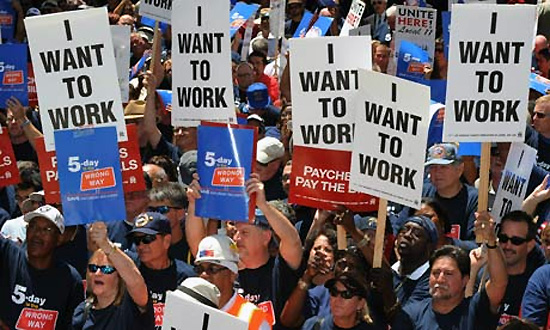
WASHINGTON (TIP): More than 4 million U.S. workers filed for jobless benefits last week, the Labor Department said Thursday, May 21. That brings the total number of people applying for aid to more than 43 million, on a seasonally adjusted basis, since the coronavirus pandemic spread across the nation.
Put another way, 1 in 4 U.S. workers has applied for jobless aid in the last 10 weeks.
“Unemployment claims made during the coronavirus crisis have already exceeded the 37 million claims made over the entire 18 months of the Great Recession,” Daniel Zhao, senior economist at Glassdoor, said in a note. “[T]he labor market remains in a deep hole it will have to climb out of.”
Some 2.4 million workers applied for regular unemployment insurance in the week ending May 16, marking a slight decrease from the week before. But nearly as many — 2.2 million — applied for aid under Pandemic Unemployment Assistance, a new federal program for self-employed and gig workers.
The self-employed were not being counted in previous weekly jobless figures until last week. The true number of jobless self-employed people is likely even higher, as not all states are currently reporting their PUA payout figures, noted economist Heidi Shierholz.
The number of first-time applications for traditional jobless aid has steadily declined each week since peaking in late March, indicating that the waves of layoffs are slowing. However, the figures remain staggering by historical standards, demonstrating that severe economic pain is widespread even as the majority of U.S. states reopen their economies.
“Reopening the economy does not necessarily equate with robust rehiring,” Andy Stettner, a senior fellow at the Century Foundation, wrote in a note. While 35 states reopened last week, nine of them actually saw an increase in the number of new workers claiming unemployment benefits, he pointed out.
“The unemployment rate now stands at a staggering 14.7% — a figure I hoped that I would never see in my lifetime, and one that is sure to get worse before it gets better,” John Williams, president of the Federal Reserve Bank of New York, said Thursday morning.
“It’s likely that the latest numbers do not reveal the full extent of the financial devastation faced by millions of American families. The data don’t capture those who had to leave their jobs, either for their own health or to take care of loved ones,” Williams said.
A congressional budget watchdog has predicted unemployment will remain above 11% for the rest of the year — higher than its peak during the Great Recession in 2009.
How soon the economy begins to recover, and how fast the recovery is, depends largely on both government economic-stimulus policy and the pace of medical progress against the novel coronavirus, Wall Street analysts say.
“It’s not impossible to imagine the economy roaring back to life once a vaccine is widely available,” Pantheon Macroeconomics wrote in a note.
The expanded unemployment benefits that have allowed many people to keep supporting themselves despite being out of work run out at the end of July. Democrats in Congress have pushed for an expansion of jobless aid, while Republican lawmakers have called for federal assistance to be phased out as shuttered employers reopen around the country.
(With input from Agencies)





Be the first to comment